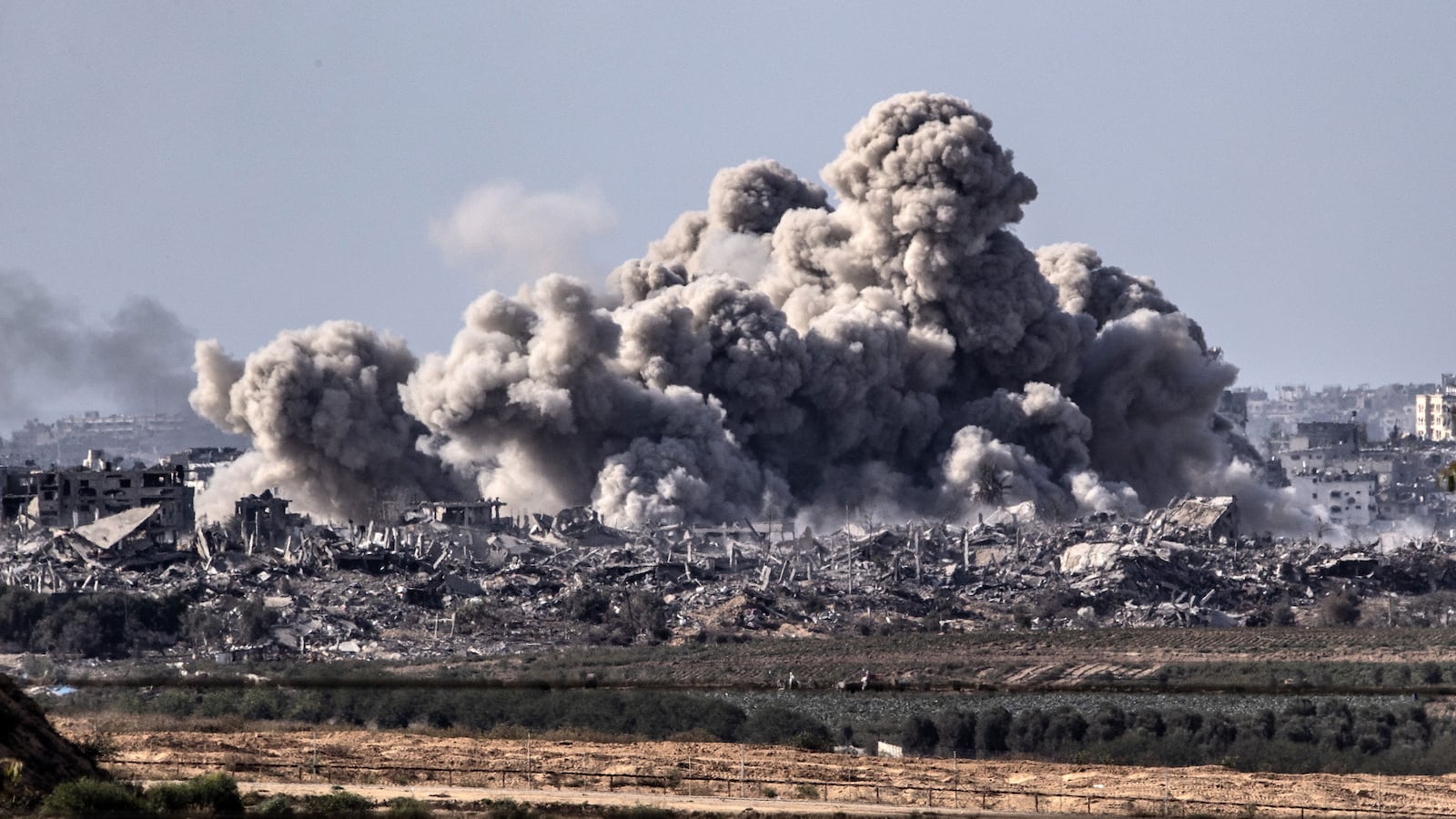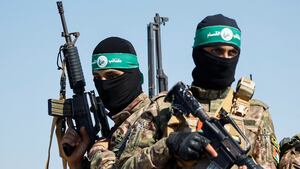One of the most important aspects of Israel’s messaging on the ongoing Gaza conflict—more accurately termed war propaganda—has been to conflate the Palestinians in Gaza, and even Palestinians in general, with Hamas and the brutal, dehumanizing attacks in southern Israel on Oct. 7.
This rhetorical conflation, coupled with rhetoric of dehumanization (Israel’s defense minister Yoav Gallant described Palestinians in Gaza as “human animals”), serves the cold imperative of rationalizing and minimizing the death and destruction currently being meted out to the 2.1 million civilians crammed into this tiny area. The alarming rhetoric by Israeli and Hamas political leaders, often matched by their actions, implicitly and even explicitly claim that there are “no civilians” on the other side.
This all-to-common sensibility of bloodlust in the midst of a conflict is exactly why the international community developed the laws of war, mainly in the 20th century, including several key instruments, like the Fourth Geneva Convention, specifically designed to outline the rights and protections of civilians caught in the middle of military campaigns.
Noncombatants are not distinguished by their political beliefs, but rather by their simple identity as civilians. By law and at least in theory they all get the same protections. Nonetheless, Israeli rhetoric—and much more importantly the imperative for a viable post-conflict political horizon in Gaza and the rest of the occupied Palestinian territories—begs the question of what Palestinians, especially in Gaza, thought before the war erupted and how that thinking may be changing.
Surveys generally are imperfect and give, at best, a partial snapshot of public opinion. Americans have become well aware of this given the outcomes of numerous recent elections. And that’s particularly true when polling is conducted under highly oppressive conditions such as the Israeli occupation and the authoritarian approaches by Hamas in Gaza and the Palestinian Authority that controls the small but densely populated self-administered enclaves in the occupied West Bank. Nonetheless, numerous organizations have made an art out of surveying Palestinians in recent years.
Two recent surveys, in particular, provide helpful indicators about public opinion in the occupied territories on the eve of the current conflict and now in its midst.
Arab Barometer, which is one of the most reliable and professional of these organizations throughout the Arab world, crucially released a poll of Palestinian public opinions that, in Gaza, was remarkably concluded on Oct. 6 and therefore provides an invaluable snapshot into perspectives in Gaza immediately before the conflict began. This week, Arab World for Research and Development (AWRAD) has released a war-time survey of Palestinian perspectives, albeit in a much smaller sample group of about half the size, that concluded a tumultuous month later, on Nov. 7. These surveys need to be read with and against each other, and as always with polling, taken with a grain of salt.
The Arab Barometer poll demonstrates that the population in Gaza had remarkably low opinions and very little trust in Hamas in the weeks leading up to the Oct. 7 attacks, which probably helps explain some of the motivation for this dramatic terrorist attack that was consciously designed to change everything. Sixty-seven percent of Palestinians in Gaza reported having “no trust at all” (44 percent) or “not a lot of trust” (23 percent) in Hamas. The most popular choice in Gaza for Palestinian president was jailed Fatah leader Marwan Barghouti, not Hamas’ titular political leader, Ismail Haniyeh. The poll found that Palestinians in Gaza also had unfavorable views of the Palestinian Authority, but that 30 percent preferred the secular nationalists of Fatah as opposed to 27 percent that preferred Hamas.
In a crucial rebuttal to Israeli efforts to paint the Palestinians both in general and especially in Gaza as hopelessly extreme and essentially, at least indirectly, responsible for the Oct. 7 attacks, this population expressed an overwhelming preference, 73 percent, for a peaceful solution to the conflict with Israel. This is in stark contrast to Hamas’ insistence on armed struggle until “victory,“ defined by the elimination of Israel.
Only 20 percent of Palestinians in Gaza, despite (or perhaps because) of living under Hamas rule since 2007, favored such a “military solution” to the conflict. Fifty-four percent supported a two-state solution along the lines envisaged by the 1993 Oslo agreements, with a Palestinian state in what are now the occupied territories living alongside Israel. That’s a remarkable level of support given how implausible such a scenario appears to have become, particularly given the Israeli government’s stated commitment to eventual large-scale annexation in the West Bank and categorical rejection of meaningful Palestinian independence.
Predictably enough, the new AWRAD poll suggests a significant negative trend has developed during the current conflict among Palestinians in general and decidedly in Gaza. According to the survey, an overwhelming majority of Palestinians of all descriptions and in all areas of the occupied territories feel that peace with Israel is less possible now, at approximately 87 percent. There is little support among Palestinians anywhere, according to this survey, for either Hamas or the PA to govern Gaza—and over 70 percent of Palestinians in both areas would like a Palestinian national unity government to emerge, at least in Gaza, after the conflict.

A view of collapsed, heavily damaged buildings after an Israeli airstrike on Beit Lahia town of Gaza on November 21, 2023.
Photo by Abdulqader Sabbah/Anadolu via Getty ImagesAlmost all Palestinians surveyed—including over 90 percent in Gaza—are more pessimistic about the possibility of peaceful coexistence with Jewish Israelis. Similar overwhelming numbers in both the West Bank and Gaza say they will neither forget nor forgive Israel’s conduct in the current conflict.
The survey found a great deal of support in the West Bank and Gaza for the Oct. 7 attacks. Supportive views of Hamas are now strong in the West Bank, with almost 90 percent being very or somewhat positive, but in Gaza it's just over 50 percent—undoubtedly reflecting many years of Hamas misrule.
Both Israel and the United States are overwhelmingly unpopular, and, interestingly, Iran is also held in considerable disrepute. Many Arab states are greatly disliked, including Egypt, Jordan, Saudi Arabia and, perhaps most strongly, the United Arab Emirates (UAE), the country that kicked off the Abraham Accords normalization process with Israel.
Support for a two-state solution has, almost inevitably, decreased in both the West Bank and Gaza by approximately the same amounts, 69 percent and 67 percent, respectively. Similar large majorities report an increase in commitment to the rather hazy language of “the restoration of historical Palestine as a final resolution,” which could be taken to mean many things but does not suggest a commitment to two states. Over 70 percent in both areas say the ideal solution would be a single Palestinian state “from the river to the sea.”
The contrast between the two polls is striking but not surprising. The Hamas-led attack on southern Israel on Oct. 7 and Israel’s ongoing response is the bloodiest, cruelest, and most destabilizing spasm of violence between Israelis and Palestinians since the contest between Jews and Arabs over control of British mandatory Palestine began to develop in the 1920s and 1930s. The extreme violence of the second intifada that developed in the fall of 2000 radicalized both Israelis and Palestinians.
The Israeli far-right, led at first by Ariel Sharon and then Benjamin Netanyahu, came to power and has largely kept it ever since. This meant effectively abandoning Israeli government support for a two-state solution and intensifying a commitment to building settlements and moving towards eventual annexation.
On the Palestinian side, an analogous process of radicalization allowed Hamas to emerge, for the first time, as a serious competitor for national leadership against Fatah, which runs the PA in the West Bank and controls the Palestine Liberation Organization (PLO) on the international stage. But in the current conflict, the death tolls on both sides in a few weeks met and then exceeded the carnage of many years during the second intifada. If the past is prologue to the present, the impact of the current savagery will be even more devastating and damaging to prospects for peaceful coexistence.
It’s too early to tell how much radicalization on both sides is being engendered by the current firmament of horror, and, especially important, how sustained that will be, but the signs everywhere are bad. The rise of overtly racist, exterminationist, and genocidal rhetoric among Israeli leaders, as well as officials from Hamas and other extreme Palestinian groups, has been striking. As the discouraging contrast between the Arab Barometer and AWRAD polls suggests, views among ordinary Palestinians have hardened greatly.
However, there are some crucial caveats. Every poll is a snapshot and a guess, particularly under current conditions in the occupied territories. The AWRAD sample is quite small—about half of that of the Arab Barometer—and the structure of the questions, at least as reflected in the full survey report, indicates that recipients were gently primed towards increasing negativity. But under the circumstances, that’s probably not necessary. It’s inevitable that this conflict, with its brutality and overwhelming civilian casualties on both sides, would engender a great deal of fear and hatred, and that that would be reflected in public sentiments.

Relatives of the deceased mourn as bodies of Palestinians killed in Israeli attacks are taken out of the mortuary of Al-Aqsa Martyr's Hospital to bury in Deir al Balah, Gaza on November 21, 2023.
Anadolu Agency/Getty Images/Anadolu Agency/Getty ImagesThe most important cautionary note is that, over time, views can shift and have a paradoxical effect.
It’s by no means impossible that, when the dust settles from the current carnage, Palestinians will take a dimmer view than ever of violence as a strategy for national liberation. There is no doubt that while the second intifada radicalized Palestinian views in general, it also laid a lasting memory for many Palestinians, especially in the West Bank, of the overwhelming price Palestinians pay in armed conflict with Israel. This is without doubt one of the key reasons that the current violence did not spread to the West Bank and occupied East Jerusalem, as Hamas clearly hoped, given that they branded the Oct. 7 attack “the Al-Aqsa Flood” (invoking Muslim holy places in Jerusalem, the third holiest city in Islam).
There is nothing preventing Israelis from concluding that the Oct. 7 killing spree demonstrates, above all, the need for a viable peace agreement with the PLO and Fatah. If Israel wants to deliver a political deathblow to Hamas, that has to involve strengthening the Fatah-dominated groups and rethinking the whole approach to the Palestinians.
After all, it was the divide-and-rule policy towards Palestinians propagated and instituted by the Israeli right that focused on keeping not only the PA in the West Bank but Hamas in Gaza in power, deeply divided and at each other's throats, weak and contained. Israel thought it had Hamas under control and the Palestinians so profoundly divided that peace negotiations were plausibly deemed pointless. But this policy is exactly what, predictably if not indeed inevitably, produced the Oct. 7 massacres.
Both Israelis and Palestinians have described this as an existential conflict, and identify the other side as genocidal. Both senior Israeli ministers and Hamas leaders have called each other Nazis. And the death toll continues to mount, above all in Gaza, where most of the population appears to be in constant motion even though nowhere is safe.
Radicalization, bitterness, and intensified hatred is the most obvious outcome of such a man-made calamity. But since neither side is going anywhere and Israelis and Palestinians therefore face a binary choice of accommodation and coexistence versus unending savagery and massacres, this could be the terrifying experience that pushes both back to the negotiating table.
Israel, in particular, has a vital choice now, it can deal seriously and constructively with those Palestinians who want a negotiated peace agreement with Israel—as opposed to cynically bolstering, while simultaneously containing and periodically cutting down to size, those Palestinians who want to shoot Israelis.
These opinion polls, particularly the larger and more reliable Arab Barometer one concluded on the eve of this bloodbath, demonstrated a strong desire for a negotiated agreement, including in Gaza, and little support for Hamas. It’s not surprising that the AWRAD survey, conducted in the midst of the worst bloodletting in the hundred-year-old conflict between Israelis and Palestinians reflects anger and despair.
But that doesn't mean that these sentiments will persist if the leaderships on both sides decide to get serious about peace talks. Indeed, the ups and downs of the Palestinian political scene—and the Israeli one, for that matter—show that public support for a reasonable agreement on both sides is largely determined by how sincerely committed to peace the other side is perceived to be.
It would be neither surprising nor unusual for the current conflict to leave nothing but hatred and rage between Israelis and Palestinians. But it's not inevitable. National leaders who are serious about finding an accommodation will still have a lot to work with once the fighting stops, providing they have a serious partner on the other side.









